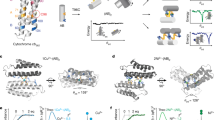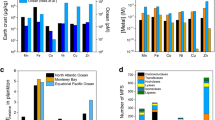Abstract
The Helix pomatia metallothionein (MT) system, namely, its two highly specific forms, HpCdMT and HpCuMT, has offered once again an optimum model to study metal–protein specificity. The present work investigates the most unexplored aspect of the coordination behavior of MT polypeptides with respect to either cognate or noncognate metal ions, as opposed to the standard studies of cognate metal ion coordination. To this end, we analyzed the in vivo synthesis of the corresponding complexes with their noncognate metals, and we performed a detailed spectroscopic and spectrometric study of the Zn2+/Cd2+ and Zn2+/Cu+ in vitro replacement reactions on the initial Zn-HpMT species. An HpCuMTAla site-directed mutant, exhibiting differential Cu+-binding abilities in vivo, was also included in this study. We demonstrate that when an MT binds its cognate metal, it yields well-folded complexes of limited stoichiometry, representative of minimal-energy conformations. In contrast, the incorporation of noncognate metal ions is better attributed to an unspecific reaction of cysteinic thiolate groups with metal ions, which is dependent on their concentration in the surrounding milieu, where no minimal-energy structure is reached, and otherwise, the MT peptide acts as a multidentate ligand that will bind metal ions until its capacity has been saturated. Additionally, we suggest that previous binding of an MT polypeptide with its noncognate metal ion (e.g., binding of Zn2+ to the HpCuMT isoform) may preclude the correct folding of the complex with its cognate metal ion.







Similar content being viewed by others
References
Capdevila M, Bofill R, Palacios O, Atrian S (2012) Coord Chem Rev 256:46–52
Palacios O, Atrian S, Capdevila M (2011) J Biol Inorg Chem 16:991–1009
Capdevila M, Atrian S (2011) J Biol Inorg Chem 16:977–989
Dallinger R, Berger B, Hunziker PE, Kägi JHR (1997) Nature 388:237–238
Palacios O, Pagani A, Pérez-Rafael S, Egg M, Höckner M, Brandstätter A, Capdevila M, Atrian S, Dallinger R (2011) BMC Biol 9:4
Chabicovsky M, Klepal W, Dallinger R (2004) Environ Toxicol Chem 23:648–655
Chabicovsky M, Niederstaetter H, Thaler R, Hödl E, Parson W, Rossmanith W, Dallinger R (2003) Toxicol Appl Pharmacol 190:25–36
Dallinger R, Chabicovsky M, Hödl E, Prem C, Hunziker P, Manzl C (2005) Am J Physiol 289:R1185–R1195
Höckner M, Stefanon K, DeVaufleury A, Monteiro F, Perez-Rafael S, Palacios O, Capdevila M, Atrian S, Dallinger R (2011) Biometals 24:1079–1092
Pérez-Rafael S, Pagani A, Palacios O, Dallinger R, Capdevila M, Atrian S (2013) Z Anorg Allg Chem 639:1356–1360
Bongers J, Walton CD, Richardson DE, Bell JU (1988) Anal Chem 60:2683–2686
Capdevila M, Domènech J, Pagani A, Tío L, Villarreal L, Atrian S (2005) Angew Chem Int Ed 44:4618–4622
Capdevila M, Cols N, Romero-Isart N, Gonzalez-Duarte R, Atrian S, Gonzalez-Duarte P (1997) Cell Mol Life Sci 53:681–688
Bofill R, Palacios O, Capdevila M, Cols N, Gonzalez-Duarte R, Atrian S, Gonzalez-Duarte P (1999) J Inorg Biochem 73:57–64
Domenech J, Orihuela R, Mir G, Molinas M, Atrian S, Capdevila M (2007) J Biol Inorg Chem 12:867–882
Fabris D, Zaia J, Hathout Y, Fenselau C (1996) J Am Chem Soc 118:12242–12243
Bofill R, Capdevila M, Atrian S (2009) Metallomics 1:229–234
Dallinger R, Wang Y, Berger B, Mackay EA, Kägi JHR (2001) Eur J Biochem 268:4126–4133
Orihuela R, Monteiro F, Pagani A, Capdevila M, Atrian S (2010) Chem Eur J 16:12363–12372
Cols N, Romero-Isart N, Capdevila M, Oliva B, Gonzàlez-Duarte P, Gonzàlez-Duarte R, Atrian S (1997) J Inorg Biochem 68:157–166
Polec-Pawlac K, Palacios O, Capdevila M, Gonzalez-Duarte P, Lobinski R (2002) Talanta 57:1011–1017
Orihuela R, Domènech J, Bofill R, You C, Mackay EA, Kägi JHR, Capdevila M, Atrian S (2008) J Biol Inorg Chem 13:801–812
Pagani A, Villarreal L, Capdevila M, Atrian S (2007) Mol Microbiol 63:256–269
Gehrig PM, You C, Dallinger R, Gruber C, Brouwer M, Kägi JHR, Hunziker PE (2000) Protein Sci 9:395–402
Ding C, Festa RA, Chen YL, Espart A, Palacios O, Espin J, Capdevila M, Atrian S, Heitman J, Thiele D (2013) Cell Host Microbe 13:265–276
Pérez-Rafael S, Mezger A, Lieb B, Dallinger R, Capdevila M, Palacios O, Atrian S (2012) J Inorg Biochem 108:84–90
Pérez-Rafael S, Kurz A, Guirola M, Capdevila M, Palacios O, Atrian S (2012) Metallomics 4:342–349
Bofill R, Capdevila M, Cols N, Atrian S, Gonzàlez-Duarte P (2001) J Biol Inorg Chem 6:405–417
Artells E, Palacios O, Capdevila M, Atrian S (2013) Metallomics 5:1397–1410
Bofill R, Orihuela R, Romagosa M, Domenech J, Atrian S, Capdevila M (2009) FEBS J 276:7040–7056
Valls M, Bofill R, Romero-Isart N, Gonzalez-Duarte R, Abian J, Carrascal M, Gonzalez-Duarte P, Atrian S (2000) FEBS Lett 533:189–194
Palacios O, Espart A, Espin J, Ding C, Thiele D, Atrian S, Capdevila M (2014) Metallomics. doi:10.1039/C3MT00266G
Capdevila M, Palacios O, Atrian S (2010) Bioinorg Chem Appl. doi:10.1155/2010/541829
Zamyatin AA (1972) Prog Biophys Mol Biol 24:107–123
Hasler DW, Jensen LT, Zerbe O, Winge DR, Vasak M (2000) Biochemistry 39:14567–14575
Muñoz A, Forsterling FH, Shaw CF III, Petering DH (2002) J Biol Inorg Chem 7:713–724
Narula S, Brouwer M, Hua Y, Armitage IM (1995) Biochemistry 34:620–631
Acknowledgments
This work was supported by the Spanish Ministerio de Economía y Competitividad, (grants BIO2012-39682-C02-01 and BIO2012-39682-C02-02 to S.A. and M.C., respectively; these grants were partially supported by FEDER funding) and by the Austrian Science Foundation (grant P 23635-B20) to R.D. The authors from Barcelona are members of the 2009SGR-1457 Grup de Recerca de la Generalitat de Catalunya. The Spanish and Austrian groups were also financed by Acciones Integradas grants HU2006-0027 (Spain) and ES 02/2007 (Austria). S.P.R. received a predoctoral fellowship from the Departament de Química, Universitat Autònoma de Barcelona. We thank the Centres Científics i Tecnològics de la Universitat de Barcelona (ICP-AES, DNA sequencing) and the Servei d’Anàlisi Química de la Universitat Autònoma de Barcelona (CD spectroscopy, UV–vis spectroscopy, ESI-MS) for allocating instrument time.
Author information
Authors and Affiliations
Corresponding author
Electronic supplementary material
Below is the link to the electronic supplementary material.
Rights and permissions
About this article
Cite this article
Palacios, Ò., Pérez-Rafael, S., Pagani, A. et al. Cognate and noncognate metal ion coordination in metal-specific metallothioneins: the Helix pomatia system as a model. J Biol Inorg Chem 19, 923–935 (2014). https://doi.org/10.1007/s00775-014-1127-4
Received:
Accepted:
Published:
Issue Date:
DOI: https://doi.org/10.1007/s00775-014-1127-4




